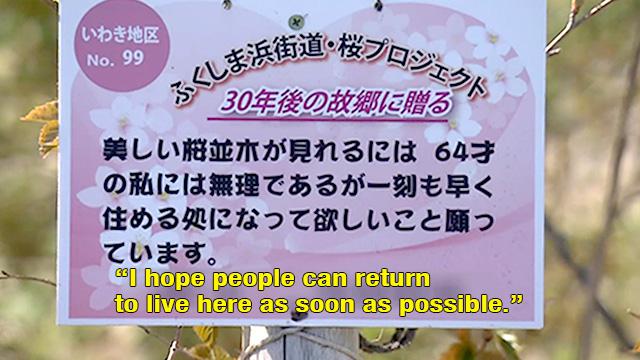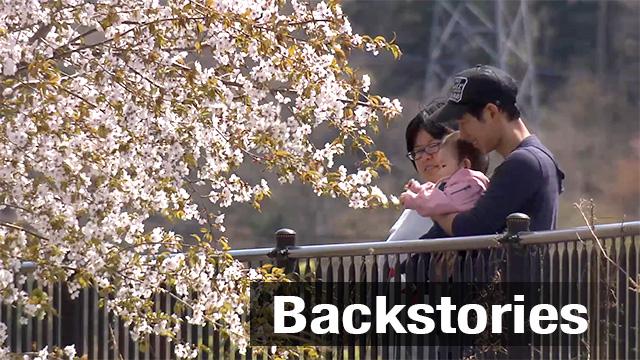They are part of a plan to plant 20,000 cherry trees along a 160-kilometer stretch of the prefecture.
Yumiko Nishimoto, a director of NPO Happy Road Net, started the project in 2013 with a group of local people, including high school students.

For a donation of more than 90 US dollars, anyone can sponsor a cherry tree and leave a message for the future.



The cherry trees are being planted in the eastern part of Fukushima in a region known as Hamadori, or "coastal path," which is home to Tokyo Electric Power Company's Fukushima Daiichi nuclear power plant.
Eight years ago, a massive tsunami hit the Hamadori coast. It triggered a meltdown at the nuclear power plant, releasing radioactive substances over a wide area, and forcing residents to evacuate.
Nishimoto's project actually dates back to before the disaster. Local high school students came up with the idea of planting cherry trees to attract visitors to the area.
But one of the students who was particularly enthusiastic about the trees was killed in the tsunami.
Although the project fizzled out for a while after the disaster, a familiar sight brought it all back to Nishimoto a year later. She saw a TV report showing one of Hamadori's best cherry blossom spots in full bloom, but cordoned off with no one around to appreciate the flowers.

Nishimoto says: “I can't explain it, but tears started rolling down my cheeks. I was bawling, and for the first time since the earthquake, I realized I had to plant those cherry trees with the children. It was a wake-up call. I had made a promise, and I needed to fulfill it.”
Nishimoto got back in touch with the high school students she had been working with. Two years after the disaster, they started to plant trees again. More than 10,000 have been planted over the last six years.
Yuki Kobori and Nishimoto met more than 10 years ago, when he was part of the project. After she got in touch again, he has been joining the team on his days off work.

Kobori grew up in the Hamadori region and found a job there after graduating from high school. But the area he knew so well was changed forever by the tsunami.
His home survived the disaster, but others weren't so lucky. While helping to clear debris he saw many bodies, including an old childhood friend.
He spoke of his feelings about that time: “There was no one here. For a while, I didn’t think the people who used to live here would ever come back. I wondered if anyone could survive here. I could only think of the worst-case scenario. Back then, I didn't have any hope. Tears would flow down my cheeks in rivers.”
Staying wasn't an option, so he was transferred by his company to an office about 80 kilometers away. Kobori had to start a new life, far from where he grew up. Now, he has rejoined the project to help revitalize an area to which he hopes to return one day.
Some areas in Hamadori are still off limits and evacuees are scattered across Japan. Nishimoto wants the new cherry blossoms to greet them when they are allowed to return.
Kobori himself welcomed a new arrival last year when his daughter was born.
In April, he visited Nishimoto’s office with his wife and daughter to write a message for the cherry trees.
"I look forward to the day we can return to my hometown, and see the cherry trees you saw with us when you were small."
Hamadori native Hiromichi Matsumoto is one of the project's regular staff. He's responsible for maintaining the trees and plaques.

Before joining the project, while he was cleaning guard rails as part of the decontamination work, he saw one of the plaques. It was a message of concern about Fukushima and encouragement to its people.
"I hope that this area will be filled with smiling faces."
He visited Nishimoto’s office to ask if he could join the team. He sees the work as a way of repaying the people who helped him when he was forced to evacuate after the disaster.
Matsumoto used to work for a construction company and was assigned to the Fukushima Daiichi power plant. He was on duty when the tsunami struck.
He says the tsunami hit as he was walking toward higher ground. It arrived with a sound like an explosion.
His home lies about 10 kilometers from the power plant. Eight years on, the evacuation order is still in place, and he has no idea when he’ll be able to go back.
Among the many messages he's seen, there’s one that stood out to him. It’s from someone who was involved in the construction of the Fukushima Daiichi power plant.
"I am ashamed to have caused the accident."
Matsumoto says: “I don’t think it’s a matter of perpetrator and victim. It’s not an issue of who's right and who's wrong, it’s about what we do about it now. When I think of how this has been weighing on him for so long, I feel like I should find a way to relieve his anguish.”
At the end of April, Kobori brought his 11-month-old daughter to see for the first time the cherry trees he helped plant.

Kobori says: "My daughter is still little, but I want her to feel hope and happiness when she sees them. These are the first cherry blossoms she has seen, and I want to bring her up so she understands what they mean, and can share this with others."
Nishimoto says: “I want people around the world to see that we won't let the nuclear disaster beat us, and that we’re turning this into the most beautiful area in the world. That's the real recovery for me.”
The road to recovery is long and hard. But the cherry trees are proof that residents will never give up on their hometown.
In March this year, Nishimoto and others involved in the cherry tree project got some good news. It was announced that the torch relay for the 2020 Tokyo Olympics will start in Hamadori.

The relay will start at the J-Village national soccer training center. Nishimoto and her high school students have already planted trees there.
The design for the Olympic torch includes a cherry blossom motif and the runners carrying it will be passing through Hamadori in late March next year, just as the trees are expected to bloom.

